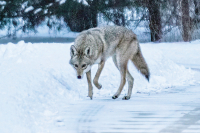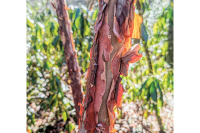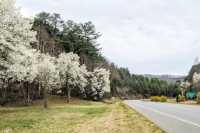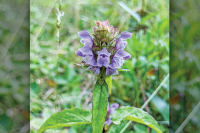How to decide?
A new rule could make it easier to open up trails in national parks to mountain biking.
Mountain biking isn’t banned in national parks as a matter of course, although it is rare to find parks where it is allowed. Before allowing mountain bikes, a park must undergo an extensive environmental analysis heavily laden with opportunities for public comment.
The rule change would loosen the requirements, allowing what amounts to an “abbreviated analysis,” said Greg Kidd, a representative with the National Parks Conservation Association Asheville office. Needless to say, Kidd’s organization is against any truncation of the process.
“We feel strongly it is important to have the full analysis and that includes public participation and opportunity for the public to weigh in,” Kidd said.
But Kent Cranford, owner of Motion Makers bike shop in Sylva, thinks the current process is so arduous that it is essentially a barrier.
“This new rule change will make that process much easier. Right now it is an ugly process,” Cranford said.
Cranford said the rule change will streamline the process, not totally skirt it.
“My understanding is that it won’t remove any barriers of making sure mountain bikes aren’t going to damage anything. They are still going to have to go through the environmental process and the approval process,” Cranford said. But it wouldn’t be as burdensome, time consuming or costly to the park.
The rule change came at the suggestion of outgoing President Bush, a mountain biker himself, in his final days in office. The proposal could be dead in the water already, however.
“When Obama came in, they put a freeze on all rule changes that had been promulgated by the outgoing administration,” said Bob Miller, spokesperson for the Great Smoky Mountains National Park. “At the end of any administration there is a lot of rule making, or changing, as they go out the door. The new administration wants to catch their breath and decide which are in play. There is no telling when this one will move forward.”
A public comment period has been underway for the rule change and will expire Feb. 17.
To read the rule change, go to edocket.access.gpo.gov/2008/E8-29892.htm. To comment, go to www.regulations.gov and use the code 1024-AD72.
— By Becky Johnson
Can mountain bikes find a home in the Smokies?
Mountain bikers face a long, steep climb in their fight to see more trails opened to tires in the Great Smoky Mountains National Park.
One of the major hurdles facing the sport is stereotypes, said Kent Cranford, a mountain biker and owner of Motion Makers bike shop in Sylva.
“People have images from TV that somebody is going to come jumping over their head or screaming by with tattoos and piercings all over,” Cranford said. “This is not a Mountain Dew commercial. Most people are effectively hiking on wheels. They want to get out in the backcountry and see the wilderness, too.”
Mountain biking would allow people to see more of the park, a lot of which is out of bounds due to distance.
“As big as that park is, penetrating in 20 miles is not something you can do without staying overnight,” said Timm Muth, a mountain biker who lives near Sylva. “But on a bike 10 miles in and 10 miles back out is very doable in a day, and it would make the park more accessible to a lot of people.”
Pam Forshee, a mountain biker in Franklin, said she rarely visits the Smokies now.
“There is nothing for me other than hiking. If I could go over there and hike and bike and camp for the weekend it would be heaven,” said Forshee, who runs Smoky Mountain Bicycles in Franklin with her husband, Dave.
“I don’t understand why the national parks have not allowed bicycles in the park all these years. We have as much right to be on the trails as anyone else.”
Cranford is a member of the International Mountain Biking Association, which has been lobbying for bike access in national parks for years. Cranford thinks they are steadily chipping away at the barriers shutting out bikes.
“It is wrong thinking to think a trail can just be this, or just that. It is all of our land,” Cranford said.
But many of the hikers and nature lovers who currently enjoy the trails of the Smokies don’t want to see mountain bikes join the mix. Reasons include wear and tear on the trails, the risk of collisions and what many consider a more intrusive form of recreation.
Greg Kidd, senior program manager with the National Parks Conservation Association Asheville office, agreed that nearby national forests provide ample opportunity for mountain bikers and a host of other recreational uses including like hunting and kayaking. But parks aren’t the place for such a smorgasbord.
“The fact is that national parks are a place apart. They are designed for a different kind of experience,” Kidd said. Besides, “The park doesn’t even have the resources to maintain the trails as currently used.”
Horses and bikes
Mountain bikers pushing for access in the Smokies often point to horses on the trails and ask: why them and not us? Horseback riders are allowed on approximately half of the park’s 800 miles of trails, with the greatest percentage being on the North Carolina side of the park.
“I think it is unfair they grandfather horses into the park and won’t allow bikes as well,” Muth said. ”Certainly any trails that are already open to horses should be open to mountain bikes. Mountain bikes have much lower impact on the trail surface than a horse.”
The mechanics of a horse hoof versus a bike tire are quite different. The horse rotates its hoof as it makes contact with the ground, gouging up the trail bed in the process. The loose soil is then more vulnerable to erosion. Mountain bikes, on the other hand, compact the soil and harden the trail’s surface, helping it stay put.
“Horses kick up the terrain a lot more than bikes do,” Forshee summed up.
But Kidd disagrees with the bikers’ line of thinking.
“Certainly there is no question that horses have an impact on the trail. But if we increase the types of uses — like bicycling — that would certainly just exacerbate the problem,” Kidd said.
Not to mention the sheer number of mountain bikers compared to horse owners, Kidd said.
“Arguably with the growing popularity of mountain biking, the amount of potential mountain bike use on those trails would dwarf the amount of horse use,” Kidd said.
But the flip side is mountain bikers would help take care of the trails they ride, Cranford said.
“That is the upside. If they let mountain bikes in, they work on trails,” Cranford said. “Ask the forest service how they feel about mountain bikers and they’ll tell you they love them because they come in like crazy to work on trails.”
Sharing the trail
Mountain bikers aren’t surprised when they encounter a backlash.
“You often have different user groups who want to be selfish and keep places to themselves,” Muth said.
But Forshee pointed to the arrangement at Tsali — where trails are designated for mountain biking and horseback riding on alternate days — as proof it can work. Even sharing the same trail, it could work, she said.
“It is a matter of using caution and proper etiquette,” Forshee said.
That etiquette calls for bikers to yield to horses, and for good reason, Muth said.
“I’ve seen guys go flying by a horse within a couple feet. They say ‘I’m not going to ride into the horse,’ but that’s not the point. You are going to scare the heck out of them,” Muth said. When they get spooked, they could buck their rider.
Instead, mountain bikers should always come to a stop, get off their bikes and offer a greeting.
“The talking helps because the horses recognize you are another person. When you are on a bike they can’t figure out what the heck all that stuff is,” said Muth.
Muth generally says “hello” then asks the horseback riders how to handle getting past. If they have skittish horses, they might ask the bikers to scoot off the trail while they navigate by.
“They are very appreciative of this,” Muth said of his approach. “Different user groups need to take the time to understand what each others needs are out there.”
While most of Muth’s encounters are friendly, there have been exceptions. In an extreme case, he came upon hunters at Tsali who stood across the trail with their guns and wouldn’t let him pass. On another occasion, his wife and son ran into a hunter who was put out by the their presence and fired shots into the air as they rode away.
Safety first
An oft-heard argument by those opposed to mountain biking is the fear of collisions.
“Part of what is fun about mountain biking is moving at a fast clip. If a bicyclist comes screaming around a bend on a trail and an unsuspecting hiker happens to be walking up that trail, that could lead to some very serious issues,” Kidd said.
Muth said there is always that chance, and has actually seen a few near collisions.
“I love to fly fast downhill and you could run into problems if you come around a blind curve and there are three or four people standing on the trail,” Muth said. “Mountain bikes need to be conscious that when they come around a blind corner they should expect there could be somebody standing there.”
By the same token, hikers should assess the vehicles at a trailhead for clues as to who is on the trail that day. If there are three or four cars with bike racks, it should signal to hikers be cautious — or pick a different trail, Muth said.
“If I know it is hunting season and there are three pickup trucks at the trailhead with gun racks, I say ‘you know, maybe I will go somewhere else,’ as much out of consideration for them as safety for myself,” Muth said. “There is plenty of room for everybody. You just have to be conscientious that everybody has a right to be doing different things.”
Not any time soon
While optimistic, bikers acknowledge they may have a long road ahead of them in their fight for access in national parks.
Bob Miller, a park ranger and spokesperson for the Great Smoky Mountains National Park, said the park has no plans in the near future to tackle the mountain bike issue.
That was pretty much the answer mountain bikers were bracing for.
“I don’t think we are going to see much in the way of trails opened up,” Cranford said.
Although a proposed rule change would make it easier for parks to open trails to mountain bikes — namely by removing the requirements for a taxing analysis — Miller said the park would take the issue seriously and opt for a thorough and comprehensive review even if it wasn’t technically required.
The top issues to weigh: would mountain biking degrade the national park experience of others using the trails and would mountain biking harm the ecosystem, Miller said.
Another question is whether the park could afford the additional ranger patrol and rescue operations that would go along with mountain biking in the park, or afford the extra trail maintenance.
Miller said such a study would be done only in the context of a parkwide planning process, not a piecemeal approach of opening a trail here and there. Overlay that with drawn out public comment periods, and you have one massive undertaking.
Miller said the Smokies has broached the subject anecdotally, but never had what you would call a formal request to take on the issue.
“The fact is we are surrounded by some pretty nice mountain bike areas already,” Miller said.
But Muth said the mountain bike trails in the Pisgah and Nantahala national forests don’t offer enough diversity, particularly by way of easier mountain bike trails. There are few options for beginners or even intermediate riders.
Mountain bikers say they aren’t advocating for a wholesale opening of all trails in the park, admitting there are some trails that simply aren’t suitable.
“I don’t think bikes should be on the Appalachian Trail,” Cranford said by example. Others would be too steep, too narrow, too rocky.
“Most of the trails there wouldn’t even be fun to ride,” Cranford said.
Likewise, Kidd isn’t opposed to bikes carte blanche.
“I think if a trail is appropriately designed and designated specifically for mountain biking use, I think there is a potential for mountain bikes to find a place in the park,” Kidd said. “As for bike use in the backcountry, we would likely find that incompatible as a blanket statement. But that’s not to say there is not a single trail in the park where it would not be appropriate.”
Broken bridge ignites debate with Park over North Shore cemeteries
Swain County residents with family buried in cemeteries in the Great Smoky Mountains National Park claim the park service is dragging its feet repairing a washed out bridge used to visit the old graves.
A bridge spanning the mouth of Hazel Creek in the North Shore area of the Park came apart last summer. It will cost upwards of $500,000 to replace it, according to the U.S. Park Service. The Park is requesting federal money to build back the bridge, but it will have to compete against dozens of other national parks for a limited pot of funds.
Dale Ditmanson, superintendent of the Smokies, came to the Swain County commissioners meeting last week, where he got an earful from a few angry Swain County residents who want the bridge repaired immediately.
David Monteith, a county commissioner, said the bridge provided a vital link for those wanting to visit cemeteries where loved ones are still buried in the Park. To reach the cemeteries in the North Shore backcountry, people generally take a ferry across Lake Fontana and walk the rest of the way on old roads, or are driven the remaining distance by park rangers.
In the summer when lake levels are up, the bridge is submerged and the ferry motors up the mouth of Hazel Creek to let people out. But when lake levels drop the rest of the year, the bridge becomes the only way to span the mouth of Hazel Creek. Without the bridge, people have to hike up and around on a narrow trail for more than a mile to reach the same cemeteries.
“Right now, the way it stands between late September and late March, it makes it totally impossible for the handicap and elderly to go up Hazel Creek,” Monteith said. “If you are on a cane, you can’t get there.”
Monteith said it also puts a crimp on visitation from hikers, backpackers and fishermen who visit the backcountry.
“That’s major money coming into Swain County,” Monteith said.
Monteith accused Ditmanson of not wanting the bridge built back. Monteith said the Park has inflated what it would actually cost to build the bridge. The higher price tag is going to keep it from being built back, Monteith said.
Monteith consulted the contractor that built the original bridge for an opinion on what it would cost today. The figure he came up with was $100,000 — not $500,000.
Monteith is a leader in the movement to build the North Shore Road, a group that has historically been at odds with the Park.
Monteith offered to write Ditmanson a check for $100,000 if he would go build the bridge back. Ditmanson wouldn’t accept it, which Monteith said shows that the Park doesn’t really want the bridge built back.
“You are trying to block us out,” Monteith said.
Monteith cited what he feels is a pattern of negligence by the Park Service toward the Swain County portion of the Park.
“This is part of us. It feels like they take everything away from Swain County,” Monteith said. “We are losing everything about the Park on this side of the mountain.”
For example, trashcans in the North Shore backcountry have been removed because rangers didn’t want to come empty them.
Monteith said the bridge could have been saved if the Park acted faster. But Park Spokesperson Bob Miller said the Park did not know the integrity of the bridge was compromised until it was too late.
“The first we heard that there was a problem with the bridge is the folks at Fontana Marina called us and said the bridge was floating in the lake,” Miller said.
The Park hired a crew of underwater divers to go in and inspect the submerged bridge and supports. They hoped they could simply tow the wooden bridge back in place and bolt it back, that perhaps the clips attaching the bridge to the beams were all that had rusted out. But it turns out the beams themselves were too corroded, Miller said.
Getting the money
Even if the Park’s request is granted, the money won’t come through until 2011 at the earliest, or 2015 more realistically.
The Park Service is typically working on a five-year time line. So projects that get money today were actually approved five years ago.
Here’s how the process works. Once a year, every park puts together a list of repairs it needs for roads, bridges and facilities. The Department of Interior looks at all the lists and decides which ones get money.
At first, the Park simply turns in a rough estimate of what the work would cost for the Hazel Creek bridge. The Smokies guessed about $500,000. If it makes the government’s short list, then the Park will engage an engineer to do a more sophisticated estimate, Miller said.
“Initially you put in a broad conceptual design and rough estimate,” Miller said. “There is no point to spend money on refining a design until you know that it is even in the pecking order.”
Typically, there’s about $90 million is the pot for road work to be shared under the Department of Interior. The requests that come in are many times that amount, usually a giant laundry list of every project every park would like to see.
“Requesting things you know will never be funded gives the Park Service some idea of how big the road needs are,” Miller said. “If you only request the top three you know will be funded it looks like ‘Oh, you got everything.’”
The pecking order
The Hazel Creek bridge could have a hard time competing for limited national park funds. Technically, it isn’t considered a road used by the public. Rather it’s classified as an “administrative” road used by park personnel only.
“It’s going to be hard for that project to compete very well,” Miller said.
The Smokies saw that disadvantage play out following the floods of 2004, which washed out another bridge in the North Shore area. The Park applied to a pot of emergency money for flood repairs, but was turned down since it was considered “public” use. At the time, Congressman Charles Taylor, R-Brevard, was serving over the subcommittee that controls park service funding and pulled strings to get the repair funded after all. Taylor has since been voted out and replaced with Congressman Heath Shuler, D-Waynesville, who doesn’t have direct sway over the Park budget.
Swain County Manager Kevin King wrote a letter to the Smokies asking for the bridge to be fixed. The letter cites the hardship on the elderly and handicapped trying to visit their family graves.
Miller said he isn’t sure if the local demands, or the issue of cemetery access, will influence the chances for funding.
“It might help to tip the balance or give it a better ranking, but it’s hard to tell,” Miller said.
Miller said the Park is not happy about the bridge washing out either, as it allowed the park rangers better access to the area as well.
But the Hazel Creek bridge replacement isn’t even at the top of the Park’s own list. The list includes items used by far more people or far more urgent, such as restrooms for visitors or saving historic structures in immediate danger of falling down.
Graves in the park
When Fontana Lake was constructed during WWII, some communities were submerged by the rising lake while others were merely rendered inaccessible.
The only road in and out of a 44,000 acre area where about 2,000 people lived got flooded, effectively cutting them off. So the area was evacuated and made part of the Great Smoky Mountains National Park. Those who were evacuated not only left behind homes and farms, but family cemeteries.
Many elected to have their loved ones remain where they were rather than dug up and relocated. The next of kin for each grave had to sign a contract with the Tennessee Valley Authority stating their preference: to leave the grave or move it.
Those who elected to leave the grave where it was were warned upfront that visitation to the cemeteries wasn’t going to be easy.
“It will be necessary to walk a considerable distance until a road is constructed in the vicinity of the cemetery, which is proposed to be completed after the war has ended,” the TVA contract stated.
Although families were given fair warning access would be difficult, they were also given hope that a road into the area would be built back one day. Those with family members buried on the North Shore have hung on to that hope, but it has been 65 years now and no road is in sight.
Road or cash
When Park Superintendent Dale Ditmanson came to the Swain commissioners meeting last week, road supporters didn’t pass up the chance to demand the long-promised road. County Commissioner David Monteith, a spokesperson for the pro-road group, suggested tapping the public works stimulus package being debated in Congress for money to build the North Shore Road.
But Ditmanson leveled with the audience.
“The road will never be built,” he said.
A cash settlement in lieu of the road is now the county’s best hope of being compensated for the broken promise to build the road. But negotiations over the amount of the settlement appear to be stalled.
Supporters of a cash settlement floated the figure of $52 million, a long-standing amount used repeatedly over the past decade when discussing a cash settlement. It is based on the value of the old road through the area that was flooded when the lake was created, adjusted for interest and inflation.
The Park Service itself adopted the figure, but now that rubber is meeting the road it appears a figure cannot be agreed on. Swain County leaders have said they will not settle for anything less.
Park’s brookie population withstands drought well
By Jennifer Garlesky • Staff Writer
The Southern Appalachian brook trout population is surviving through the drought that has been plaguing Western North Carolina this past year, according to Great Smoky Mountain National Park fisheries biologists Matt Kulp.
An artist’s journey: Landscape artist Craig Forrest brings his love of art full circle
By Sarah Kucharski • Staff Writer
It’s almost as though one can hear the creaking sighs of the old, hand-hammered barn boards in Craig Forrest’s paintings. His brush strokes evoke the weathered wood with its gentle warps, many knotholes, and varied colors.
Climate Change vs. National Park: New report predicts environmental crises while Park works on solutions
By Michael Beadle
More acid rain and invasive insect pests. Fewer trout in mountain streams. More “code red” days with poor air quality and less visibility.
These are some of the dangers threatening the Great Smoky Mountains National Park if efforts aren’t made now to curb toxic chemicals from spewing into the earth’s atmosphere.
North Carolina side of park needs bigger, better visitors center
The Great Smoky Mountains National Park has known it needed a new visitors center on the North Carolina side of the park since the early 1980s. Finally, it appears the nation’s most-visited national park is going to get one, and the communities surrounding the park should be glad the time has finally come.
Fire on the mountain
By Sarah Kucharski • Staff Writer
A forest fire burned nearly 40 acres in the Great Smoky Mountains National Park on Wednesday (Feb. 28), threatening the Purchase Knob research station.
Smokies National Park conducts 530-acre prescribed burn
The Great Smoky Mountains National Park conducted a prescribed burn on a 530-acre tract of forest in the Cataloochee Valley area last weekend.









